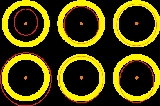
Saturn-crosser asteroid
Encyclopedia
A Saturn-crosser is a minor planet
whose orbit
crosses that of Saturn
. The known numbered Saturn-crossers (as of 2005) are listed below. There is only one inner-grazer (944 Hidalgo
) and no outer-grazers or co-orbitals known; most if not all of the crossers are centaurs.
Notes: † inner-grazer.
Minor planet
An asteroid group or minor-planet group is a population of minor planets that have a share broadly similar orbits. Members are generally unrelated to each other, unlike in an asteroid family, which often results from the break-up of a single asteroid...
whose orbit
Orbit
In physics, an orbit is the gravitationally curved path of an object around a point in space, for example the orbit of a planet around the center of a star system, such as the Solar System...
crosses that of Saturn
Saturn
Saturn is the sixth planet from the Sun and the second largest planet in the Solar System, after Jupiter. Saturn is named after the Roman god Saturn, equated to the Greek Cronus , the Babylonian Ninurta and the Hindu Shani. Saturn's astronomical symbol represents the Roman god's sickle.Saturn,...
. The known numbered Saturn-crossers (as of 2005) are listed below. There is only one inner-grazer (944 Hidalgo
944 Hidalgo
944 Hidalgo is a small Solar System body with a semi-major axis beyond Jupiter's and an orbital period of 13.77 years. This makes it a centaur, but it was discovered in 1920 and has hence traditionally been considered an asteroid....
) and no outer-grazers or co-orbitals known; most if not all of the crossers are centaurs.
Notes: † inner-grazer.
- 944 Hidalgo944 Hidalgo944 Hidalgo is a small Solar System body with a semi-major axis beyond Jupiter's and an orbital period of 13.77 years. This makes it a centaur, but it was discovered in 1920 and has hence traditionally been considered an asteroid....
† - 2060 Chiron2060 Chiron2060 Chiron is a minor planet in the outer Solar System. Discovered in 1977 by Charles T. Kowal , it was the first-known member of a new class of objects now known as centaurs, with an orbit between Saturn and Uranus.Although it was initially classified as an asteroid, it was later found to...
- 5145 Pholus5145 Pholus5145 Pholus is a centaur in an eccentric orbit, with a perihelion less than Saturn's and aphelion greater than Neptune's. Pholus has not come within one astronomical unit of a planet since 764 BC, and will not until 5290. It is believed that Pholus originated as a Kuiper belt object.It was...
- 5335 Damocles5335 Damocles5335 Damocles is the archetype of the Damocloids, asteroids that are inactive nuclei of the Halley Family and long-period comets. It was discovered in 1991 and named after Damocles, a figure of Greek mythology....
- 8405 Asbolus8405 Asbolus8405 Asbolus is a centaur, that is, an icy asteroid that orbits between Jupiter and Neptune. It was discovered by James V. Scotti and Robert Jedicke of Spacewatch at Kitt Peak Observatory on April 5, 1995. It is named after Asbolus , a centaur in Greek mythology...
- (15504) 1999 RG33
- 20461 Dioretsa20461 DioretsaDioretsa is a centaur discovered in 1999 notable for its unusual orbit, which is highly eccentric and retrograde. Its name is the word 'asteroid' spelled backwards to reflect this fact...
- 31824 Elatus31824 Elatus31824 Elatus , provisionally known as 1999 UG5, is a centaur discovered on October 29, 1999, by the Catalina Sky Survey.- External links :*...
- 32532 Thereus32532 Thereus32532 Thereus , provisionally known as 2001 PT13, is a Centaur discovered on August 9, 2001 by the Near-Earth Asteroid Tracking project at Palomar.- External links :*...
- (37117) 2000 VU2
- 52872 Okyrhoe52872 Okyrhoe52872 Okyrhoe is a centaur orbiting in the outer Solar System between Jupiter and Neptune. It was discovered on September 19, 1998, by Spacewatch.-Orbit:Centaurs have short dynamical lives due to strong interactions with the giant planets...
- 60558 Echeclus60558 Echeclus60558 Echeclus is a centaur in the outer Solar System. It was discovered by Spacewatch in 2000 and initially classified as an asteroid with provisional designation . Research in 2001 by Rousselot and Petit at the Besançon observatory in France showed no evidence of cometary activity, but in late...
- (63252) 2001 BL41
- (65407) 2002 RP120(65407) 2002 RP120' holds the distinction of being the most eccentric of the numbered asteroids . It is also a member of the very exclusive group of retrograde asteroids, which has only two numbered members...
See also
- List of Mercury-crossing minor planets
- List of Venus-crossing minor planets
- List of Earth-crossing minor planets
- List of Mars-crossing minor planets
- List of Jupiter-crossing minor planets
- List of Uranus-crossing minor planets
- List of Neptune-crossing minor planets

